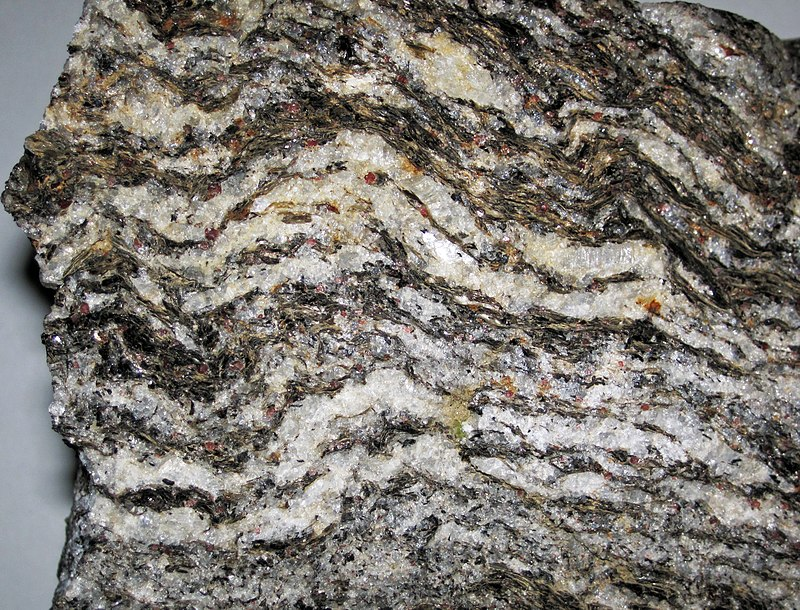Gneis
Bildinfo und Lizenz
Bildinfo
- Ein typischer Gneis mit gut erkennbarer Parallel-Struktur (Bänderung): dieses Stück aus Indien entstand in der erdgeschichtlich fernen Zeit des Präkambriums.
- Originalbeschriftung: Gneiss from the Precambrian of India. (field of view ~7.35 cm across)
- Metamorphic rocks result from intense alteration of any previously existing rocks by heat and/or pressure and/or chemical change. This can happen as a result of regional metamorphism (large-scale tectonic events, such as continental collision or subduction), burial metamorphism (super-deep burial), contact metamorphism (by the heat & chemicals from nearby magma or lava), hydrothermal metamorphism (by superheated groundwater), shear metamorphism (in or near a fault zone), or shock metamorphism (by an impact event). Other categories include thermal metamorphism, kinetic metamorphism, and nuclear metamorphism. Many metamorphic rocks have a foliated texture, but some are crystalline or glassy.
- Gneiss is a high-grade, foliated metamorphic rock. It differs from lower grade foliated metamorphics, such as slate, phyllite, and schist, by having alternating bands of light and dark minerals. Metamorphism has been so intense that minerals have segregated into discrete zones. Most gneisses form by metamorphism of schists or granites.
- The gneiss shown above is from the Himalayan Mountains of India and has well-defined foliation with crenulations. The dark bands are rich in biotite mica. The light-colored bands are dominated by quartz and feldspar. The small red crystals are garnet.
- Stratigraphy: Joshimath Formation, lower Vaikrita Group, Higher Himalayan Crystalline Belt, Proterozoic
- Locality: outcrop in the town of Joshimath, Uttarakhand State, Himalayan Mountains, northern India
- Pandey et al. (1981) - Rb-Sr age data for the gneissic rocks from Dhakuri, Joshimath and Guptakashi areas of Central Crystalline Zone, Kumaon Himalaya, U.P. pp. 56/1-56/6 in: National Symposium on Mass Spectrometry - Progress in Research, Applications, and Instrumentation, Bhabha Atomic Research Centre, December 21-23, 198
Source
- Created: April 18th, 2016
- Author: James St. John
License
This file is licensed under the Creative Commons Attribution 2.0 Generic license. Dieses Werk darf von dir verbreitet werden – vervielfältigt, verbreitet und öffentlich zugänglich gemacht werden sowie neu zusammengestellt werden – abgewandelt und bearbeitet werden. Zu den folgenden Bedingungen: Namensnennung – Du musst angemessene Urheber- und Rechteangaben machen, einen Link zur Lizenz beifügen und angeben, ob Änderungen vorgenommen wurden. Diese Angaben dürfen in jeder angemessenen Art und Weise gemacht werden, allerdings nicht so, dass der Eindruck entsteht, der Lizenzgeber unterstütze gerade dich oder deine Nutzung besonders. Weitergabe unter gleichen Bedingungen – Wenn du das Material wiedermischst, transformierst oder darauf aufbaust, musst du deine Beiträge unter der gleichen oder einer kompatiblen Lizenz wie das Original verbreiten. Link zur Lizenz: https://creativecommons.org/licenses/by/2.0/deed.en
Warranty
- No guarantee can be given as to the correctness of facts implied or explicitly stated.
- Usage is completey at your own risk. 💣
Originalseite
- Das Bild ist Teil eines online-Lexikons.
- Rhetos Lernlexikon Mathematik, Aachen:
 Ein typischer Gneis mit gut erkennbarer Parallel-Struktur (Bänderung): dieses Stück aus Indien entstand in der erdgeschichtlich fernen Zeit des Präkambriums.
© James St. John => Zurück zum Artikel
Ein typischer Gneis mit gut erkennbarer Parallel-Struktur (Bänderung): dieses Stück aus Indien entstand in der erdgeschichtlich fernen Zeit des Präkambriums.
© James St. John => Zurück zum Artikel
